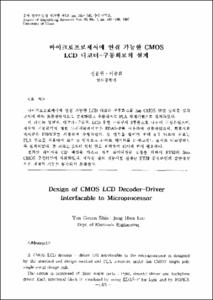LNG의 냉온열을 이용한 액화/고화 탄산 제조사이클의 설계
- Alternative Title
- Design of liquid/solid carbon dioxide production cycle using LNG cold/hot energy
- Abstract
- 액화 및 고화시스템은 운전시 많은 동력(암모니아 냉각 시스템을 도입할 때 고화탄산 1톤 생산 당 상업적으로 260 kW 정도의 동력이 필요)이 소요된다. LNG가 보유한 냉열과 발열량(LNG의 냉온열)을 효율적으로 이용하기 위하여, 본 연구에서는 액화/고화 탄산 제조사이클과 이의 동력원인 가스터빈의 조합사이클을 설계하였다. LNG의 발열량은 가스터빈의 연소열로 사용되었으며, LNG의 냉열은 액화/고화 탄산 제조사이클의 응축기 냉각용으로 또 가스터빈의 압축기 입구온도 저감용으로 사용되었다. 이에 따라 액화/고화 탄산제조사이클의 압축동력이 기존의 암모니아 냉동식 보다 50%이상 감소되었으며, 가스터빈에서도 압축동력이 감?老篤? 따라 상대적으로 순일이 증가되었다 결과로서 고화탄산 생산비율에 따라 CO2 사이클 측의 설계변수들(압축동력, 유량, 온도, 냉열용 소요 LNG 유량)파 가스터빈의 작동특성 및 최대출력조건에서 설계변수들(순일, 효율, 유량, 온도, 연료용 및 냉열용 LNG 유량)이 제시되었다. 실제 사용될 때를 위해, 본 조합사이클의 운전 변수들에 대한 설계 맵도 함께 제시하였다.
When operating liquefaction/solidification sistems, large compression power is required, frequently amounting to 260 kW in the case of a commercial dry ice production cycle with ammonia cooling. This· can be solved by utilizing liquefied natural gas(LNG) cold energy in CO2 condenser. In this study, a combined cycle is devised and simulated to reduce the compression power and to use the overall energy contained in LNG. The combined cycle is composed of two cycles; one is an open cycle of liquid/solid carbon dioxide production cycle utilizing LNG cold energy in CO2 condenser and the other is a closed gas turbine cycle which supplies power to the CO2 cycle, utilizes LNG cold energy for lowering the compressor inlet temperature, and uses the heating value of LNG in the burner. The power for the CO2 cycle operation is investigated in terms of the related properties including mass flow rates of the compressor and temperatures in the precooler as a function of a production ratio of solid CO2. The gas turbine operating characteristics, such as net work and efficiency, are also shown as a function of compression pressure ratio. When the combined cycle is operated at the maximum power condition of the gas turbine, the related mass flow rates (such as mass flow rate of the gas turbine working fluid and mass flow rates of LNG used for both fuel and cold energy) is presented as a function of a production rate of solid CO2. The present study shows that much reduction in compression power(less than 50% of power used in conventional dry ice production cycle) and CO2 condenser pressure could be achieved by utilizing LNG cold energy and high efficiency(55.3% at maximum power condition) in the gas turbine could be accomplished with the adoption of compressor inlet cooling and regenerator. For practical use, a design-purpose map of operating parameter of the combined cycle is also presented.
When operating liquefaction/solidification sistems, large compression power is required, frequently amounting to 260 kW in the case of a commercial dry ice production cycle with ammonia cooling. This· can be solved by utilizing liquefied natural gas(LNG) cold energy in CO2 condenser. In this study, a combined cycle is devised and simulated to reduce the compression power and to use the overall energy contained in LNG. The combined cycle is composed of two cycles; one is an open cycle of liquid/solid carbon dioxide production cycle utilizing LNG cold energy in CO2 condenser and the other is a closed gas turbine cycle which supplies power to the CO2 cycle, utilizes LNG cold energy for lowering the compressor inlet temperature, and uses the heating value of LNG in the burner. The power for the CO2 cycle operation is investigated in terms of the related properties including mass flow rates of the compressor and temperatures in the precooler as a function of a production ratio of solid CO2. The gas turbine operating characteristics, such as net work and efficiency, are also shown as a function of compression pressure ratio. When the combined cycle is operated at the maximum power condition of the gas turbine, the related mass flow rates (such as mass flow rate of the gas turbine working fluid and mass flow rates of LNG used for both fuel and cold energy) is presented as a function of a production rate of solid CO2. The present study shows that much reduction in compression power(less than 50% of power used in conventional dry ice production cycle) and CO2 condenser pressure could be achieved by utilizing LNG cold energy and high efficiency(55.3% at maximum power condition) in the gas turbine could be accomplished with the adoption of compressor inlet cooling and regenerator. For practical use, a design-purpose map of operating parameter of the combined cycle is also presented.
- Issued Date
- 2001
- Type
- Research Laboratory
- Alternative Author(s)
- Lee, Geun Sik
- Publisher
- 공학연구논문집
- Language
- kor
- Rights
- 울산대학교 저작물은 저작권에 의해 보호받습니다.
- Citation Volume
- 32
- Citation Number
- 2
- Citation Start Page
- 11
- Citation End Page
- 28
- Appears in Collections:
- Research Laboratory > Engineering Research
- 파일 목록
-
-
Download
 000002024119.pdf
기타 데이터 / 317.89 kB / Adobe PDF
000002024119.pdf
기타 데이터 / 317.89 kB / Adobe PDF
-
Items in Repository are protected by copyright, with all rights reserved, unless otherwise indicated.